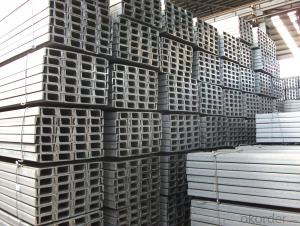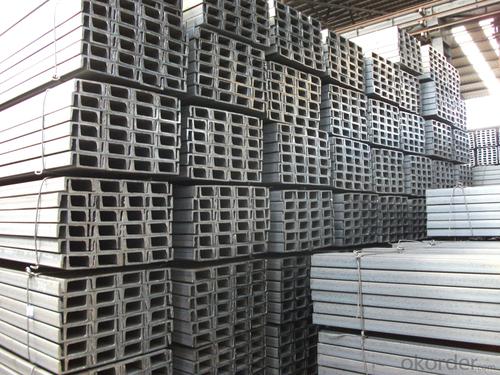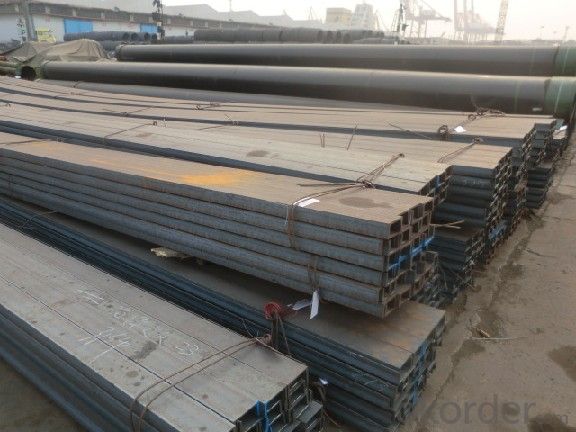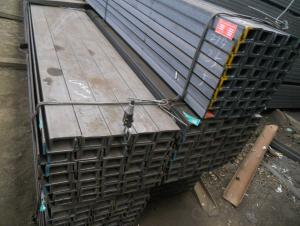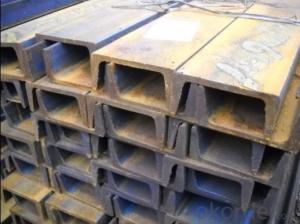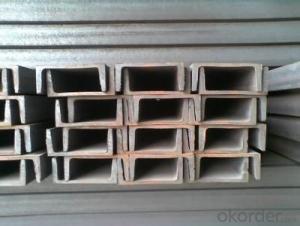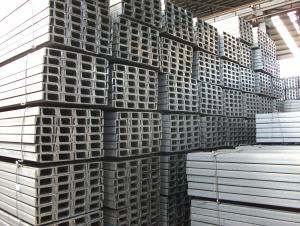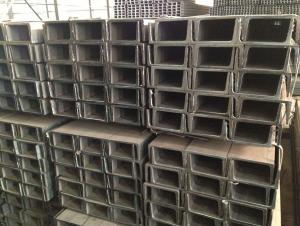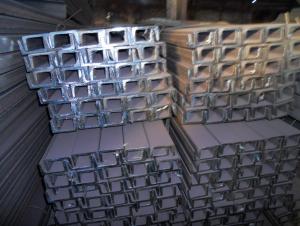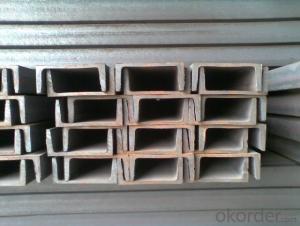Q235 16# Steel Channel
- Loading Port:
- China Main Port
- Payment Terms:
- TT OR LC
- Min Order Qty:
- -
- Supply Capability:
- -
OKorder Service Pledge
OKorder Financial Service
You Might Also Like
Steel Channel
Standard: GB
Material: Q235
Length: 6m, 12m
Size:
| Size (mm) | Mass (Kg/m) |
| 160*63*6.5 | 17.240 |
| 160*65*8.5 | 19.752 |
The chemical composition of HR Channel Steel according to Q235B is shown in Table-1.
Alloy No | Grade | Element(%) | ||||
C | Mn | S | P | Si | ||
Q235 | B | 0.12-0.20 | 0.3-0.7 | ≦0.045 | ≦0.045 | ≦0.3 |
Table-1
Note: we are able to present our customers relevant SGS test report for chemical composition of HR Channel Steel.
The mechanical property of HR Channel Steel according to Q235B is shown in Table-2
Alloy No | Grade | Yielding Strength Point(Mpa) | |||
Thickness(mm) | |||||
≦16 | >16-40 | >40-60 | >60-100 | ||
≧ | |||||
Q235 | B | 235 | 225 | 215 | 205 |
Table-2
Package & Delivery of MS Channel:
1.The hot rolled channel steel will be packed in bundle with steel wire at each end of every bundle and color marking in order to help the customer to recognize his goods more easily at sight.
2. And the hot rolled channel steel could be loaded into 20ft or 40ft container, or by bulk cargo.If the weight of each bundle reaches more than 3.5 mt, the loading by break bulk cargo should be choosed.When the weight of each bundle reaches less than 3mt, the loading by container should be choosed.
3.As for the transportaion from mill to loading port, the truck will be usually used. And the maximum quantity for each truck is 40mt.
4.All in all, we could do in accordance with customer's request.
*If you would like to get our price, please inform us the size, standard/material and quantity. Thank you very much for your attention.
- Q: Are steel channels suitable for the power generation industry?
- Yes, steel channels are suitable for the power generation industry. Steel channels provide strong structural support and can withstand the heavy loads and forces commonly found in the power generation industry. Additionally, steel channels offer excellent durability and resistance to corrosion, making them ideal for long-term use in power plants and other power generation facilities.
- Q: How long do steel channels typically last?
- Steel channels typically have a long lifespan and can last for several decades, depending on various factors such as the quality of the steel, the environmental conditions it is exposed to, and the level of maintenance and care it receives. In general, steel channels are known for their durability and resistance to corrosion, making them highly suitable for a wide range of applications in construction and industrial settings. With proper installation and regular inspections, steel channels can easily last 30 to 50 years or even longer. However, it is important to note that factors such as exposure to harsh chemicals, extreme temperatures, and heavy loads can affect the lifespan of steel channels. Therefore, it is crucial to follow recommended maintenance practices and ensure proper protection to maximize their longevity.
- Q: How do steel channels compare to other structural materials like wood or aluminum?
- Steel channels have several advantages over other structural materials like wood or aluminum. Firstly, steel channels are much stronger and more durable than wood, making them suitable for heavy-duty applications. Additionally, steel channels have a higher resistance to fire, pests, and decay compared to wood. Compared to aluminum, steel channels have a higher load-bearing capacity, making them more suitable for supporting heavy loads. Moreover, steel channels offer better resistance to corrosion and extreme weather conditions. Overall, steel channels are a preferred choice for structural applications due to their superior strength, durability, and resistance to various environmental factors.
- Q: What is the difference between channel steel and C steel?
- Channel steel is rail steel, relatively thick. C steel is rolled by iron plate
- Q: Large steel channel used for steel structural staircases
- If not sure, can see 15j401 Gangti atlas. Choosing proper channel steel can not only ensure the structural safety, but also achieve the goal of saving the cost! Hope to help you!
- Q: Are steel channels suitable for industrial applications?
- Yes, steel channels are suitable for industrial applications due to their strength, durability, and versatility. They can be used in various industrial settings such as construction, manufacturing, and infrastructure projects, providing structural support, framework, and reinforcement. Steel channels offer excellent load-bearing capacity, resistance to corrosion, and the ability to withstand high temperatures, making them reliable and cost-effective choices for industrial applications.
- Q: Can steel channels be used in sports facility construction?
- Yes, steel channels can be used in sports facility construction. They are commonly used to provide support and structural integrity to various components of the facility, such as bleachers, scoreboards, and equipment racks. Steel channels offer strength, durability, and versatility, making them suitable for withstanding the demands of a sports facility environment.
- Q: Specification for channel steels used in fork trucks
- Specifications are as follows:25a:250x78x7x1228a:280x82x7.5x12.530a:300x85x7.5x13.5
- Q: What are the design considerations for steel channels?
- Some design considerations for steel channels include the load capacity, structural stability, corrosion resistance, and compatibility with other building materials. Additionally, factors such as the intended use, environmental conditions, and cost-effectiveness also play a role in the design process.
- Q: What are the safety considerations when working with steel channels?
- When working with steel channels, it is necessary to consider several safety factors. To begin with, it is crucial to wear the appropriate personal protective equipment (PPE) such as safety glasses, gloves, and steel-toed boots. This will help safeguard against potential hazards like sharp edges, flying debris, and falling objects. Furthermore, it is vital to inspect the steel channels for any defects or damage before commencing work. This involves checking for cracks, bends, or corrosion that could jeopardize the structural integrity of the channels. If any issues are detected, they should be rectified or the channels should be replaced to maintain a safe working environment. Proper lifting techniques and equipment should be employed when handling steel channels to prevent strain or injury. Since steel channels can be heavy and cumbersome to maneuver, using lifting aids like cranes, hoists, or forklifts can significantly reduce the risk of accidents or musculoskeletal injuries. Another safety consideration is ensuring the proper storage and stacking of steel channels. They should be stored in a designated area that is free from obstructions and away from other materials that may pose a risk of falling or causing damage. Stacking should be done securely and stably, with heavier or larger channels placed at the bottom to prevent toppling. When cutting or welding steel channels, it is important to adhere to proper safety procedures. This includes using the appropriate tools and equipment, ensuring adequate ventilation in enclosed spaces to prevent the accumulation of toxic fumes or gases, and wearing respiratory protection if necessary. Fire prevention measures, such as keeping fire extinguishers nearby and keeping flammable materials away from the work area, should also be implemented. Lastly, clear communication and coordination among workers are essential when working with steel channels. This can help prevent accidents, ensure awareness of potential hazards or risks, and facilitate prompt response in case of emergencies. By following these safety considerations when working with steel channels, the risk of accidents, injuries, and property damage can be minimized, creating a safer work environment for everyone involved.
Send your message to us
Q235 16# Steel Channel
- Loading Port:
- China Main Port
- Payment Terms:
- TT OR LC
- Min Order Qty:
- -
- Supply Capability:
- -
OKorder Service Pledge
OKorder Financial Service
Similar products
Hot products
Hot Searches
Related keywords
